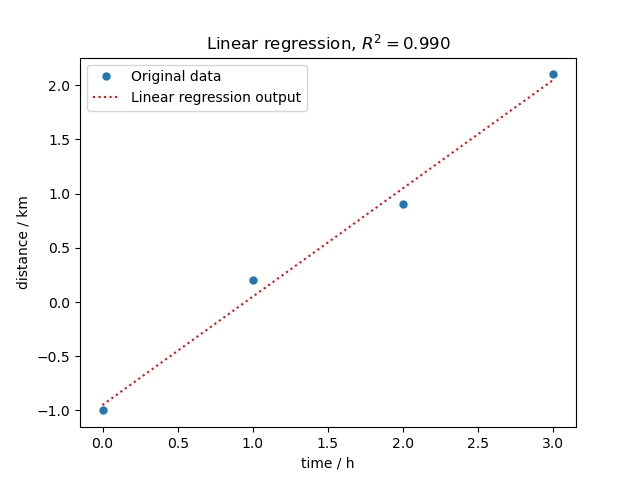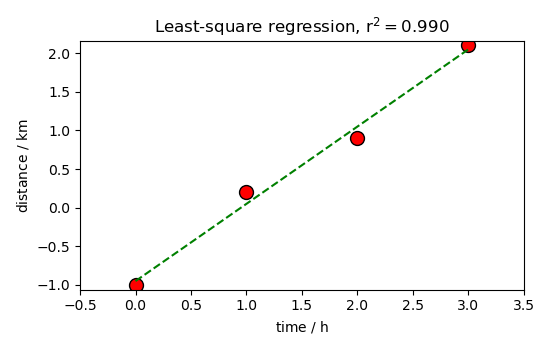Note
Go to the end to download the full example code
Solve a linear equation using LSTSQ¶
In this example, we find the least square solution of a simple linear equation.
# sphinx_gallery_thumbnail_number = 2
import spectrochempy as scp
Let’s take a similar example to the one given in the numpy.linalg
documentation
We have some noisy data that represent the distance d traveled by some
objects versus time t:
t = scp.NDDataset(data=[0, 1, 2, 3], title="time", units="hour")
d = scp.NDDataset(
data=[-1, 0.2, 0.9, 2.1], coordset=[t], title="distance", units="kilometer"
)
Here is a plot of these data-points:
d.plot_scatter(markersize=7, mfc="red")

<_Axes: xlabel='time $\\mathrm{/\\ \\mathrm{h}}$', ylabel='distance $\\mathrm{/\\ \\mathrm{km}}$'>
We want to fit a line through these data-points of equation
By examining the coefficients, we see that the line should have a gradient of roughly 1 km/h and cut the y-axis at, more or less, -1 km.
Using LSTSQ, the solution is found very easily:
lst = scp.LSTSQ(t, d)
v, d0 = lst.transform()
print("speed : {:.3fK}, d0 : {:.3fK}".format(v, d0))
speed : 1.000 kilometer.hour^-1, d0 : -0.950 kilometer
Final plot
d.plot_scatter(
markersize=10,
mfc="red",
mec="black",
label="Original data",
suptitle="Least-square fitting " "example",
)
dfit = lst.inverse_transform()
dfit.plot_pen(clear=False, color="g", label="Fitted line", legend=True)

<_Axes: xlabel='time $\\mathrm{/\\ \\mathrm{h}}$', ylabel='distance $\\mathrm{/\\ \\mathrm{km}}$'>
Note: The same result can be obtained directly using d as a single
parameter on LSTSQ (as t is the x coordinate axis!)
lst = scp.LSTSQ(d)
v, d0 = lst.transform()
print("speed : {:.3fK}, d0 : {:.3fK}".format(v, d0))
# scp.show() # uncomment to show plot if needed (not necessary in jupyter notebook)
speed : 1.000 kilometer.hour^-1, d0 : -0.950 kilometer
Total running time of the script: ( 0 minutes 0.401 seconds)